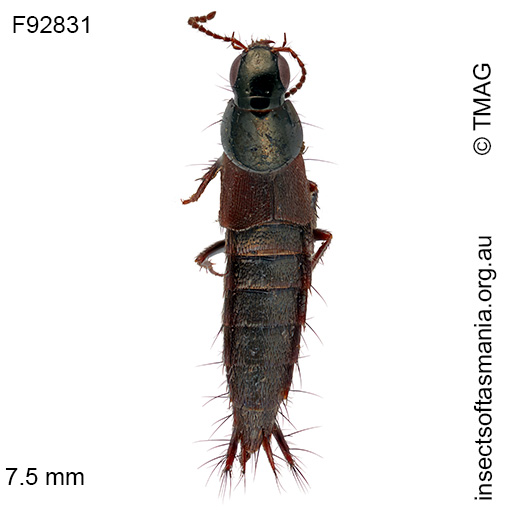
Quedius leai Scheerpeltz, 1933 (a species of rove-beetle)
Basis for Tasmanian occurrence
Semmens, T.D., McQuillan, P.B. & Hayhurst, G. (1992). Catalogue of the Insects of Tasmania. Government of Tasmania: Department of Primary Industry, 104 pp. (as Quedius duplopunctatus)
TMAG collections
Classification
Order: Coleoptera
Suborder: Polyphaga
Superfamily: Staphylinoidea
Family: Staphylinidae
Subfamily: Staphylininae
Tribe: Staphylinini
Morphology
Typical length (mm): 7
Flightedness: winged and assumed capable of flight
Ecology
Assumed larval feeding: predator
Association with dead wood or old trees: at least facultatively saproxylic
Ecological attributes: — May occupy logs or trunks of Eucalyptus obliqua, at least temporarily, since found having emerged within six years of felling (Grove et al., 2009).
Collection method(s) for TMAG material: — Emergence trapping from cut billets of Eucalyptus obliqua (Harrison, 2007) — Emergence trapping from log of Eucalyptus obliqua — Malaise trapping — Pitfall trapping — Sticky trapping on Eucalyptus obliqua.
Source ecological literature:
Grove, S. et al. (2009). A long-term experimental study of saproxylic beetle … succession in Tasmanian Eucalyptus … logs… In: Fattorini, S. (Ed.), Insect Ecology and Conservation. Research Signpost, pp. 71-114.
Harrison, K.S. (2007). Saproxylic beetles associated with habitat features in Eucalyptus obliqua trees in the southern forests of Tasmania. PhD thesis, Dept. of Zoology, Univ. of Tasmania, Hobart.
Yee, M. (2005). The ecology and habitat requirements of saproxylic beetles native to Tasmanian wet eucalypt forests: potential impacts of commercial forestry practices. PhD thesis, Univ. of Tasmania, Hobart.

